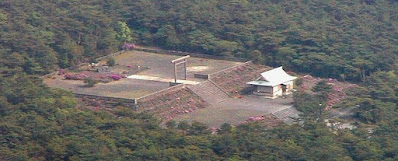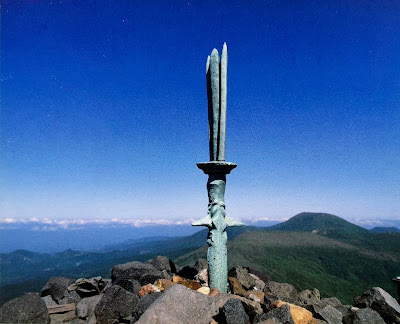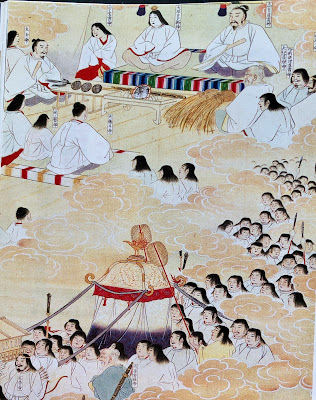目次 / Contents
1) 聖域 / Sacred Precincts
2) 社殿 / Shrine Buildings
A. 当初の社殿 / Original Shrine
B. 神仏習合 / Shinbutsu-shūgō
C. 何度も何度も / Again And Again
.jpeg) |
霧島神宮・境内マップ 本日、29日は、鹿児島交通タクシーのSさんの案内で、 目指して、観光をしました。 Kirishima-jingu Shrine Precinct Guide Map in Japanese From 26th of September to 1st of October Today, on the 29th, we went sightseeing Kagoshima Kotsu Taxi's driver, S San. This section is about 'Kirishima-jingu Shrine - By Eruptions'. 画像は下記より / These from below |
1) 聖域 / Sacred Precincts
 |
| 入り口 霧島神宮の大鳥居と神橋周辺のマップです。 Entrance This is a map of Otorii gate and Kami bridge of Kirishima-jingu Shrine. |
私はファンタジーが好きなので、'別の国'、'別の世界’を感じたり、考えたりするのが好きです。
いつも神社へ参拝するときに、どこからが聖域なのかというのを意識します。
神社の多くは、鳥居や橋があるので、そこが境界であると思います。
霧島神宮は、 大鳥居と神橋があり、
神宮公式 サイト : ★
歩いての参拝なら、大鳥居と神橋をすぎ、階段を上り、二の鳥居をくぐり、表参道を歩きます。
ですが私達は、タクシーで神宮の駐車場まで行ったので、表参道は歩いていません。
 |
| 大鳥居 / Otorii Gate |
Sacred Precincts
I like fantasy, so I like to feel and think about 'another country' and 'another world'.
Whenever I visit a shrine, I am conscious of where the sanctuary begins.
Kirishima-jingu Shrine has Otorii gate and Kami Bridge : Sacred Bridge, and I think that is the boundary.
The Shrine official website : ★ only in Japanese
Japan.guide.com : ★ in English
If you are going to worship on foot, you will pass through the Otorii gate and Kami Bridge, climb the steps, pass through the second torii gate, and walk along Omotesando approach.
However, we took a taxi to a car park of the Shrine, so we didn't walk along the Omotesando approach.
神橋より撮影
川は見ることができませんでした。
現地では川音と思った音は、風の音だったのでしょうか?
地図に川は表示されていません。
地図に川は表示されていません。
Video From the Bridge.
The river could not be seen.
Was the sound that I thought was the sound of the river
actually the sound of the wind?
The river is not shown on the map.
2) 社殿 / Shrine Buildings
A. 当初の社殿 / Original Shrine
霧島神宮は、天孫降臨 (テンソンコウリン) の地が、
高千穂峰 (タカチホノミネ) という説をとっています。
前回のセクションで、天孫降臨について書きました(下記)。
ちなみに、第一峰は、 韓国岳 (カラクニダケ) で、標高約1700m、ここが天孫降臨の地という説もあります。
霧島神宮の当初の社殿は、
"欽明天皇 (キンメイテンノウ/ 509? - 571?/ 在位:539 - 571) の
 |
霧島神宮 元宮 欽明天皇が建てた社殿の跡地は、 '霧島神宮 元宮' と呼ばれています。 その一方で、元々は高千穂峰そのものを信仰の対象とする 山岳信仰から始まった神社であるとも考えらています。 人々は火山をおそれ、そしてまた敬ったのです。 この画像は、ムック・"一個人"より [2013 / KK ベストセラーズ]The Site of Original Kirishima-jingu Shrine The site of the shrine built by Emperor Kinmei is called "Kirishima-jingu Motomiya" : 'Original Kirishima-jingu Shrine'. On the other hand, it is also believed that the shrine originated from Mountain Worship, with Mt. Takachiho itself as the object of worship. People feared and revered volcanoes. This image from a mook : "Ikkojin" [2013 / KK Bestsellers]  霧島神宮 元宮 こんな場所にあったら、噴火で何度も火事になるのは わかります。 The Site of Original Kirishim-jingu Shrine If it was in a place like this, I can understand that eruptions would cause many fires. 画像は下記より / This from below ★ |
Original Shrine
Kirishima-jingu Shrine has a theory that Mt. Takachiho (Takachiho-no-Mine) is the place where Tenson-kōrin in Japanese mythology.
In the last section, about Tenson-kōrin, below.
Mt. Takachiho is a volcano located on the border of Miyazaki and Kagoshima prefectures, it is 1,574m above sea level and is the second highest peak of the Kirishima mountains.
By the way, the first peak is Mt. Karakuni (Karakunidake), which is about 1,700m above sea level, and there is also a theory that this is the place where Tenson-kōrin descended.
The original shrine building of Kirishima-jingu Shrine was built on
a Seto hill in 540 during the reign of
Emperor Kinmei (509? - 571?/ reign:539 - 571 ).
B. 神仏習合 / Shinbutsu-shūgō
創建後、何度も噴火により炎上し、788年で焼失しました。
村上天皇 (ムラカミ テンノウ / 926 - 967 / 在位 : 946 - 967) の治世下、950年に
性空上人 (ショウクウショウニン / 910 - 1007) が、社殿を
高千穂河原 (タカチホガハラ) に移し、再興しました。
現在、ここは "霧島神宮・古宮址" (フルミヤアト) になっています。
現世利益・病魔退散を期待した皇室や貴族の庇護を受け、国家仏教になります。
性空上人は社殿を再興し、加えて天台宗のお寺、華林寺 (ケイリンジ) も創建したと考えられます。
当時、神社 (神道) よりも、華林寺に重きがおかれていたのかもしれません、少なくとも性空上人にとっては。
社殿と寺は別棟で、'華林寺跡'という記載が、現在の境内マップにあります。
高千穂河原では、 '天孫降臨の神話' と '山の神・山岳信仰' と仏教が結びついて、 霧島神宮は再建されたのですね〜。
日本は、古き時代から、神道と仏教が融合され、昔も今も、人々は違和感を抱かないのだと思います。
日本人の素地に、神仏習合思想があるのだな〜と思います。
人間の力ではどうにもならない存在に、畏敬の念をもち、敬い、その1つの形が神社なのでしょう。
 |
| 霧島神宮・古宮址 霧島神宮・"古宮址" は、 高千穂河原 (瀬多尾越 / セトオゴシ) にあり、 天孫降臨の聖地と信じられています。 Furumiya-ato : The Site of Original Shrine "Furumiya-ato : The Site of Original Shrine" of Kirishima-jingu Shrine is located in Takachiho-gawara and is believed to be the sacred place of Tenson-kōrin. 画像は下記より/ This from below★  霧島神宮・古宮址 Furumiya-ato : The Site of Original Shrine 画像は下記より/ This from below ★ |
Shinbutsu-shūgō
After it was built, it burned down again and again due to eruptions and was destroyed in 788.
During the reign of Emperor Murakami (926 - 967 / reign : 946 - 967),
Shouku Shonin (910 - 1007) moved it to Takachiho-gahara and rebuilt it in 950.
Today, this place has become "Furumiya-ato : The Site of Original Shrine" ofKirishima-jingu Shrine.
Shouku Shonin was a monk of the Tiantai sect and trained at the Kirishima mountains and Mt. Sefuri.
He was a Lotus Sūtra follower belonging to the Hijiri : monk training, while walking the world with a background in mountain Buddhism.
In the Heian Period (794 - 1185), 'Mountain Buddhism: Sangaku Bukkyo' merged with Mountain Worship, and became the state Buddhism under the patronage of the imperial family and aristocrats, who hoped to benefit the world and ward off sickness.
Shouku Shonin rebuilt the shrine, and it is believed that he also founded the Tiantai sect temple, Keirin-ji Temple.
At that time, the Temple may have been more important than the Shrine (Shinto), at least for Shouku Shonin.
The Shrine and the Temple were separate buildings, and there is a description of 'the site of Keirin-ji Temple' on the current map of the precincts.
At Takachiho-gahara, Kirishima-jingu Shrine was rebuilt by combining 'Myth of the Tenson-kōrin' and 'Mountain Gods' and 'Mountain Worship' with Buddhism.
In Japan, Shinto and Buddhism have been amalgamated since ancient times, and I think that people haven't had a sense of incongruity since ancient times.
I think that there is Shinbutsu-shūgō : a syncretism of Shintoism and Buddhism in the nature of the Japanese people.
A shrine is one way to have a sense of awe and respect for an existence that cannot be helped by human power.
 |
天孫降臨神籬斎場 "天孫降臨神籬斎場" (テンソンコウリンヒモロギサイジョウ) は、 そこに、1940年、皇紀2600年記念事業の一つとして、 作られました。 私達は、ここには行っていません。 Tenson-kōrin Himorogi-saijou "Tenson-kōrin Himorogi-saijou" : "Tenson-kōrin Alter Space" was made in 1940 as part of the 2600th anniversary of the Imperial era. We did not visit here. 画像は下記より/ This from below★ |
<補足>
下記、Wikiより
"「ひもろぎ」(古代には「ひもろき」)の語源は、「ひ」は神霊、「もろ」は天下るの意の「あもる」の転、「き」は木の意とされ、神霊が天下る木、神の依り代となる木の意味となる"
 |
| 月次祭 "古宮址"では、現在、月次祭 (ツキナミノマツリ)が 毎月10日に行われています。 また、毎年11月10日夕刻に天孫降臨御神火祭 (テンソンコウリンゴジンカサイ) が 開催されています。 Monthly Festival : Tsukinaminomatsuri At the "The Site of Original Shrine", the monthly festival is currently held. In addition, the Tenson-kōrin-gojinka-sai is held every year on the evening of November 10th. 画像は下記より/ This from below ★ |
C. 何度も何度も / Again And Again
性空上人が建てた社殿も何度も噴火に巻き込まれ、炎上し、1234年の大噴火で焼失します。
霧島市田口 (現、霧島中学校北側) に、場所を移し、仮宮を経て、
約250年間、祀られます。
1484年、島津氏の第11代当主
ですがその社殿も、何度も炎上しました。
島津 吉貴 (シマズ ヨシタカ / 1675 - 1747 / 在任 : 1704 - 1721) が1715年に建て、寄進したものです。
神社から仏教的な要素が排除され、霧島神社のみが残り、華林寺は
廃寺 (ハイジ) になりました。
霧島神宮の社殿の歴史を知ると、殴られても殴られても立ち上がる
ボクサーのような印象を持ちます。
(「立つんだ!ジョー!」的な?<笑>)
それは、人間が超自然的な何かに挑んだり、縋ったり(スガッタリ) する様にも思えます。
Again And Again
The Shrine built by Shouku Shonin was also involved in eruptions many times, burned down, and was destroyed in a major eruption in 1234.
The shrine was moved to Taguchi, Kirishima (now the north side of Kirishima Junior High School) and had been enshrined there for about 250 years.
In 1484, the 11th head of the Shimazu Clan, Tadamasa Shimazu (1463 - 1508) ordered (with funding) the Shingon Buddhism monk, Kenkei Shounin (? - ?) to revive it which is the current Kirishima-jingu Shrine.
However, the Shrine buildings also burned down many times.
The current Shrine building was built in 1715 and donated by Yoshitaka Shimazu (1675 - 1747 / reign : 1704 - 1721), the 21st head of the Shimazu Clan and the 4th Lord of the Satsuma Domain.
In 1868, the Meiji Government issued an ordinance to separate Shintoism and Buddhism (Shinbutsu Hanzen-rei : ★) in order to make Shinto the national religion.
Buddhist elements were removed from shrines, so Keirin-ji Temple was closed, leaving just Kirishima-jingu Shrine.
Knowing about the history of the Shrine's buildings, I get the impression that they are like boxers who stand up after being beaten, again and again.
It also seems that humans are sometimes trying to challenge, and at other times imploring something supernatural.
次のセクションは、'三の鳥居まで' についてです。
The next section is about 'Up to San-no-torii gate'.






















